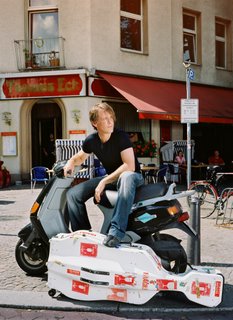
Alban Gerhardt, cellist |
Thursday evening, the National Symphony Orchestra presented a program of Rachmaninoff and Prokofiev to a large Kennedy Center audience. Programming the two Russian composers alongside each other inevitably leads one to the question of which is better, instead of reverentially evaluating each on his own respective merit. Hans Graf, Music Director of the Houston Symphony, opened the program with Respighi’s orchestration of three of Rachamninoff’s Études-tableaux.
La mer et les mouettes (“The Sea and the Seagulls,” op. 39, no. 2) depicted what must have been a rather dreary day by the sea. A melancholic churning from the strings pervaded the entire movement, while the seagulls were represented by combinations of winds and brass occasionally rising from the texture of the sea. La foire (“The Fair”) was a fun, yet brief, splash of percussive color, especially compared to the somewhat bland Marche (“March”) that opened the program.
Cellist Alban Gerhardt first came onto the Ionarts radar because of his last appearance with the NSO, in 2006 (when Jens unforgettably summed up Gerhardt's unusual hair style with the words, "that hair is just two years from being designated a comb-over"). Gerhardt joined the orchestra this time for Prokofiev’s Sinfonia concertante for Cello and Orchestra, a work the composer expanded from his cello concerto for Mstislav Rostropovich. The solo cello part is primarily an extension of the busy, string-dominant orchestra, leaving Gerhardt at times working overly hard.
The side effects from this aggressiveness at times included a lack of sinuous legato, as well as rough edges in terms of attacks and releases. In fairness, this type of raw, uncontained playing can be thrilling. Gerhardt’s instrument sounded best in its highest range, where the German cellist handled fast notes in the second and third movements explosively. The dialogue between a single flute and high cello harmonic note was most clever as Gerhardt convincingly made his cello sound like a flute. Gerhardt also offered a fitting encore by Rostropovich.
Equally loaded with color, the music of Rachmaninoff and Prokofiev seemingly contain palettes of contrasting colors. Whereas the Prokofiev features dark hues of browns and dark greens, Rachmaninoff’s Symphony No. 3 in A Minor included bright hues of red, yellow, and orange. While the Prokofiev penetrated the audience’s being, experiencing the Rachmaninoff was similar to watching a fireworks display – brilliant, yet distant. The string section’s velvety lushness was emotive, though Rachmaninoff perhaps had an oversight in not including a memorable melody in the entire work. His sometimes predictable harmonic tangents are most effective in tandem with a beautiful tune. Moments of solo flute accompanied by harp were gorgeous. Maestro Graf's passive conducting left much to be desired in terms of musical leadership, though the NSO musicians confidently carried through in their own right. In hindsight, the introspective Prokofiev and outward Rachmaninoff balanced each other nicely.
This concert repeats tonight and tomorrow night (March 14 and 15, 8 pm), in the Kennedy Center Concert Hall.






















































1 comment:
I was at the concert last night and Gerhardt was truly wonderful. There indeed was a "raw" quality to a lot of the piece, but the piece calls for it, in my opinion. I am surprised that you did not mention the HORRIBLE accompaniment by the NSO. They were constantly behind the soloist and they were rarely well together themselves. It is a shame that this piece, which is incredible, was given very little respect by the orchestra.
Post a Comment